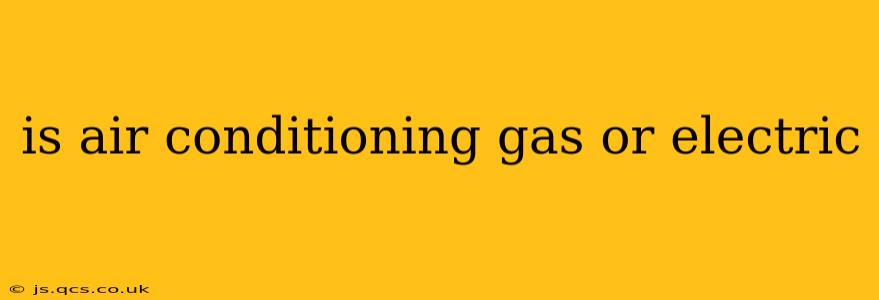Is Air Conditioning Gas or Electric? Understanding the Cooling Process
The simple answer is: air conditioning systems use both gas and electricity. It's not an "either/or" situation, but rather a sophisticated interplay of these two energy sources to achieve cooling. Let's break down how this works.
What role does electricity play in air conditioning?
Electricity is the primary power source for your air conditioner. It drives the entire system, powering the compressor, fan motors (both inside and outside the unit), and the control system. Think of electricity as the engine that makes the whole cooling process possible. Without electricity, your AC unit won't function at all.
- Compressor: The heart of the system, the compressor is an electrically powered pump that circulates the refrigerant (the "gas" we'll discuss next). This is where the significant electricity consumption occurs.
- Fans: Fans circulate air over the evaporator coil (inside) and condenser coil (outside) to facilitate heat exchange. These are also electrically powered.
- Control System: The thermostat, wiring, and control board all rely on electricity to regulate the temperature and operation of the entire system.
What is the "gas" in air conditioning? Is it really gas?
The "gas" in your air conditioning system is actually a refrigerant, a special fluid that undergoes a phase change (liquid to gas and back) to absorb and release heat. It's not a gas in the same way as natural gas used for cooking or heating. Modern refrigerants are carefully engineered to be environmentally friendly, unlike older refrigerants that depleted the ozone layer. Common refrigerants include R-410A and R-32.
The refrigerant absorbs heat from the air inside your home as it evaporates (changes from a liquid to a gas). This cooled air is then circulated through your home. The refrigerant then releases this absorbed heat outside through the condenser coil, completing the cycle.
What are the different types of air conditioners?
There are various types of air conditioners, but they all use electricity and refrigerant in their core function. These include:
- Central Air Conditioners: These systems cool an entire house using a network of ducts and vents.
- Window Air Conditioners: These are smaller units that fit into a window and cool a single room.
- Split Systems: These systems have an outdoor unit and an indoor unit connected by refrigerant lines. They’re often more energy-efficient than window units.
- Ductless Mini-Splits: These systems offer zoned cooling, allowing you to cool specific rooms independently without the need for extensive ductwork.
How much electricity does an air conditioner use?
The electricity consumption of an air conditioner varies greatly depending on its size, efficiency rating (SEER rating), and the size of the space it's cooling. Larger homes and hotter climates will require more powerful (and therefore higher energy-consuming) units. Looking for a high SEER rating is key to minimizing electricity use.
Is it cheaper to use gas or electric air conditioning?
Direct comparison between "gas" and "electric" air conditioning isn't straightforward. Most residential air conditioning units are electric. There are some systems that use gas for heating, but the cooling component remains electric. The cost ultimately depends on your electricity rates and the efficiency of your AC unit.
In summary, while the refrigerant is often referred to as "gas," air conditioning fundamentally relies on both electricity to power the system and refrigerant to perform the cooling function. Understanding the interplay of these two elements is crucial for efficient and effective cooling.
